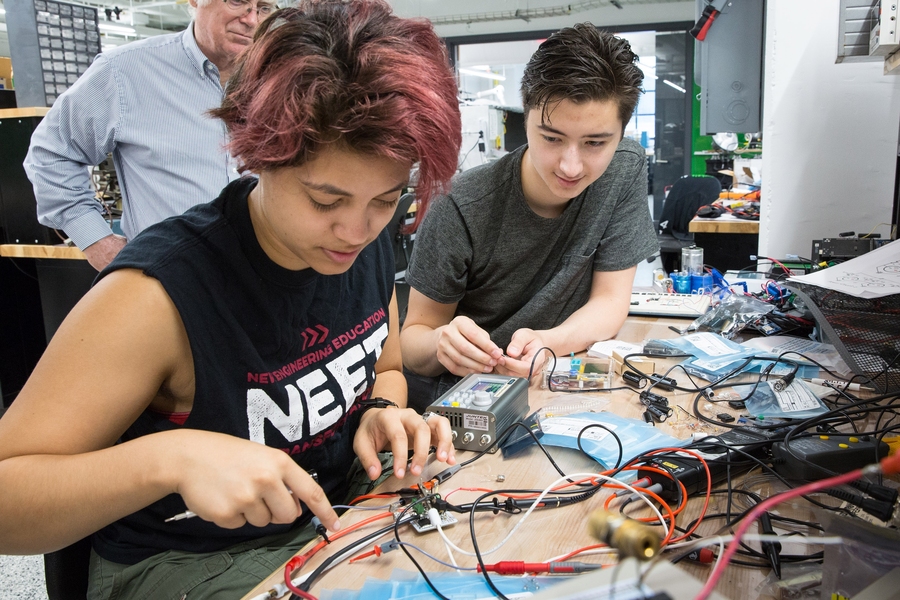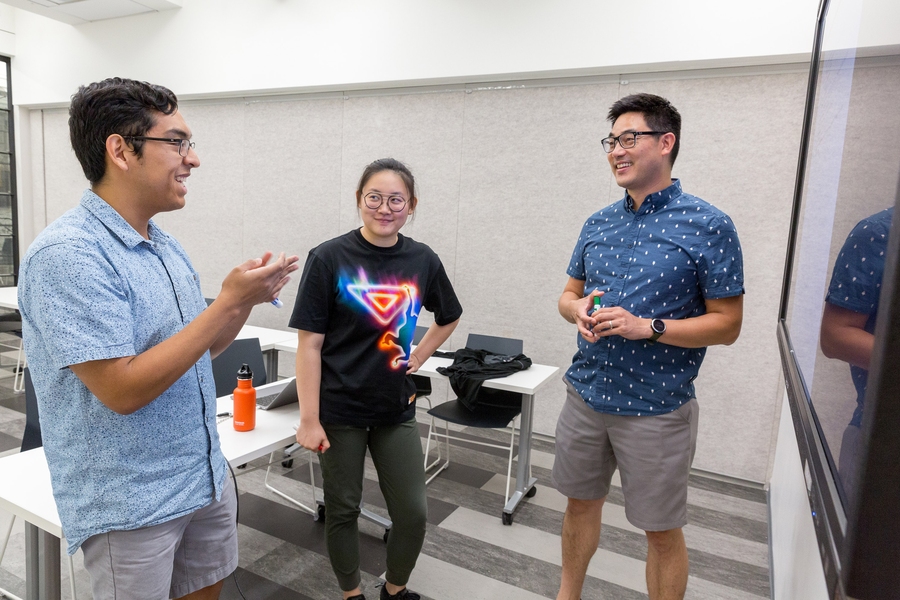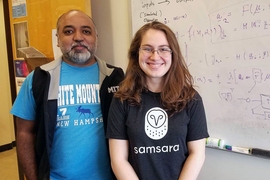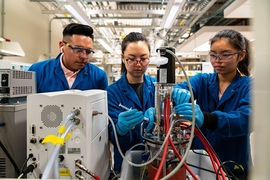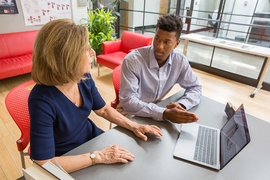Grace Bryant is a junior at MIT, but it wasn’t until this summer that she got a chance to team up with students outside her major through the Undergraduate Research Opportunities Program (UROP), supported by the MIT Energy Initiative (MITEI). She says she found the experience eye-opening.
“I rarely interact with people doing something different from what I study,” says Bryant, who is majoring in urban studies and planning with computer science. “Talking to people with other majors about what they think their careers will look like was pretty cool, and something I don’t think I would have had without this experience.”
Every summer, UROP students work with faculty on groundbreaking, real-world research; roughly 90 percent of MIT undergraduates will do a UROP before they graduate. Most undertake individual projects, but for those who team up with other undergraduates there are often added benefits — the chance to collaborate, learn from peers, and literally lend a hand — reflecting the kind of experience they’re likely to find in the workplace.
“You never know who is going to change your perspective on your own work,” says Rachel Shulman, the undergraduate academic coordinator for MITEI, which funded 22 UROP students this summer, including multiple teams. “Energy is by definition multidisciplinary.”
“It's a realistic working environment,” says William Lynch, a research specialist in the Research Laboratory of Electronics (RLE) who supervised two MITEI UROP students on a project focused on extending battery life. “In industry, people work together in teams.”
A helping hand
Some of the payoffs of collaboration are obvious. One of Lynch’s advisees, PJ Hernandez, was at work this summer and suddenly noticed their lab partner, Jackson Gray, struggling to wire a circuit with one hand; he’d recently broken his wrist. Hernandez had often turned to Gray for help on their project because he had a stronger background in electronics. Helping him build the circuit provided a chance to return the favor.
“I’m really lucky there is another UROP,” says Hernandez, a senior majoring in electrical engineering. “Jackson has been helping me understand a lot.”
Gray says working with Hernandez was great for him too — and not just because of his bad wrist. “We can work through the math together to be sure we’re not doing something fundamentally wrong,” says Gray, a junior in electrical engineering. “It’s useful just to have someone to question you and make you justify your ideas.”
James Kirtley, professor of electrical engineering and principal investigator for the RLE project, says he likes to team up students for just this reason. “The very best teachers are students, so it is reasonable to expect that the experienced student will teach the less experienced students what he or she knows,” he says. “And the ambitious but less experienced student will, by asking questions, prod the more experienced student to think more broadly about the problem.”
For Hernandez and Gray, the problem was how to develop an improved cell voltage balancer, a device used to extend the life of batteries by working to ensure that cells remain evenly charged as the battery cycles (charges and discharges current). They were hoping to improve on existing designs, since most balancers today work by dissipating extra charge as heat. As Gray explains, “If the battery management system sees that some cells are more charged than others, it will just waste that energy.”
Gray says he hopes to find a way to balance batteries more efficiently — perhaps by moving charge from one cell to another — in part because batteries are so important to his hobbies. “I enjoy working on electric vehicles and small robots, both of which use lithium ion batteries,” a major focus of the project, he says.
Hernandez’s interest in the project stems more from an interest in environmentalism, since making batteries more efficient should reduce waste: “Reducing our carbon footprint, reducing energy consumption, is really important,” they say.
Learning from others
Hernandez and Gray bolstered each other coming from the same field, but UROPs from different majors gain additional benefits from teaming up — as Bryant discovered by working with Yeva Yin, a junior in business analytics, and Luis Garcia, a senior math major, on a project for David Hsu, associate professor of urban and environmental planning.
Hsu’s project follows up on research conducted over a decade ago that showed that electricity rates are higher in areas where the local utility has spent money on lobbying. Hsu hypothesizes that this connection has grown in the wake of the Citizens United ruling by the U.S. Supreme Court, which declared corporate spending on political candidates to be protected free speech — a decision that has led to a huge increase in such spending.
Hsu employed the UROP team to gather data on state and federal campaign contributions, examine the voting patterns of utility regulators, and dig into the biographies of regulators to see what industries and companies they came from and went to after their service. The team also gathered information about the rates requested by companies, the cases presented for those rates, and the rates ultimately set for electricity—all public information.
Hsu divvied up tasks so that each student took a different dive through the material, and says each individual’s work really complemented the others’. “I like to give each student a piece to be responsible for and make it overlap with the larger project,” Hsu says. “It gives students more independence and more ownership … They can learn more than they would by themselves.”
“We all have different ideas and strengths, and that helps in coming up with different ways to approach topics,” says Yin. For example, she says she often uses applied skills in business analytics but knows less about the underlying theory; Garcia has had almost the exact opposite experience as a math major.
“Studying math, there’s a lot of theory,” Garcia says. “So it’s easier for me to come up with a plan and visualize it. But when it comes time to implement the plan, that’s a newer experience.”
Garcia investigated lobbying data — the amount of money donated by whom and to whom — and he says he learned a lot. “Working with real-world data … you have to decide what you won’t need, what’s actually important,” he says. By contrast, in math, “nothing is a strong judgment call,” he says.
Expanding horizons
All the students on UROP teams agree that collaboration speeds up the research. As Bryant remarks, “If you have a lot of work on your plate, you can redistribute the work, which is super useful.”
Bryant also says the UROP gave her new insight into American government and finance. “I just really wasn’t aware of how the energy system was regulated. I get electricity in my house, and that’s it. It’s really exciting to have that insight into how that system works and how it plays into the larger economy.”
Garcia says the lessons he’s learned about utility lobbying and regulation are helping him decide his next career steps. “I’m maybe going into public policy or political science, so I feel like having exposure to this type of work could be really helpful,” he says.
Teaming up on a UROP isn’t just valuable in terms of research and education, as Bryant discovered. In her case, talking about Hsu’s project led to a discussion about how government works and how big corporations behave. This, in turn, led to a thoughtful conversation about career options.
“We talked about careers, and it’s a conversation I haven’t had with people outside my major,” Bryant says, noting that she and her fellow UROPs discussed the trade-offs of going into well-paid jobs in industry versus focusing on a career that gives back to one’s community. “There was this whole ethical portion of the discussion,” she says. “It was pretty influential in how I think about jobs now.”
According to Shulman, this kind of experience is just what MITEI hopes to foster by sponsoring team-based undergraduate research. “I’m a big believer in serendipity,” she says. “How can we engender serendipity? You throw people together who might not otherwise have met each other.”
